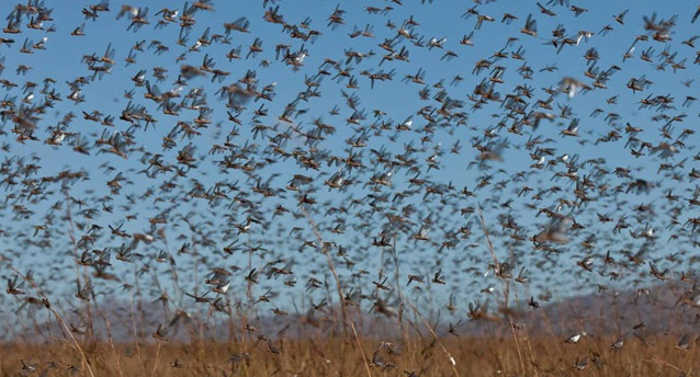News
Uganda allocates UGX 7 billion for aerial locust control

Locusts are the most destructive pests, according to experts
The government has allocated an additional UGX7 billion towards the control of the marauding dessert locusts that have invaded Uganda through the eastern side.
The Commissioner for Crop Production in the Ministry of Agriculture Animal Industry and Fisheries (MAAIF) Stephen Byantwale Tibaijuka told a news conference this morning that the money will held them mount an effective aerial attack against the locusts.
“The UGX7 billion is to be used in hiring, maintenance and remuneration of the aircrafts and personnel which is an expensive activity as an aircraft is hired at 120,000 dollars per month. Pilots and engineers are also paid highly like those in commercial flights as it is a competitive industry,” said Byantwale.

Locusts are very difficult to control because they multiply very fast
Byantwale added that the government is set to receive an aircraft from the Desert Locust Control Organization for East Africa (DLCOEA) and another aircraft was provided by Kibimba rice scheme but its pilot was hired to fly other aircrafts in Kenya as the Ministry is doing its best to bring him back.
“We were able to get one aircraft from Kibimba rice scheme, two drones from Kingdom rice and we hope these will help us in aerial spraying but also we are negotiating with farmland aviation (a private company) in Kenya to hire us two aircraft at a moderate cost as we intensify in the fight against the locusts,” said Byantwale.
Byantwale said as government they are facing a challenge in securing the specific aircraft as those available are being used by other countries that had earlier been attacked by the locusts.
The Sunrise has learned that although the Desert Locust Control Organization for East Africa (DLCOEA) owns 8 aircraft, Uganda can access just one at the moment as the rest are being used by other countries where the locust menace started.
The government’s response comes amid complaints from a different corners of the country that the government response is too little too late.
On Monday, Members of Parliament from Karamoja sub-region held a press conference in which they blamed the government’s response as being too late.
“There was an early warning and there is late response by the government. Some Ugandan Ministers have travelled to Kenya to negotiate for aircraft that be used for aerial spray. What have they been doing all along? Or why didn’t we prepare as soon as the alerts were made,” asked MP Samson Lokeris, the MP for Dodoth East County.
The MPs further noted that whereas the locust alerts have been on for nearly a month, the purchase of chemicals and deployment of man power was done only this week.
The MPs concerns are shared by a number of Ugandans who have asked why the government delayed in its response, but also why it failed to join efforts with neighboring countries like Kenya under the East African Community (EAC) to combat the menace before it spreads to other countries.
The government has deflected the criticism, insisting that it is reasonably prepared to face the locusts. Byantwale said they have gained experience from Kenya on fighting the insects and that local governments have been urged to avail water and tractors in support of the cause.
Byantwale said a 2000 strong force of men and women from Joint forces that are trained on spraying has been assembled at Ollilim barracks Katakwi awaiting deployment.
But the deployment of foot soldiers to undertake ground control has been criticized by experts from Makerere University saying that ground control is ineffective in controlling a swam of locusts that flies above 200 meters above the the ground.
Dr. Perpetra Akite, an entomologist from Makerere University, described the choice of two chemicals Cypermethrin and Chlorpyrifos to control the locusts, will endanger the environment as these chemicals are not made for wide-scale pest control.
Uganda’s representative to DLCOEA Evarist Magara said they had recommended a more friendly chemicla known as Fenitrothion for locust control.
Byantwale insisted that the government will go ahead with Cypermethrin despite the criticism.
Governments Intervention in fighting locusts.
According to Byantwale, the government has been able to rally a standby force.
As part of the intervention, government has also mobilized 200 motorized pumps, 300 Knapsack spray pumps, 200 sets of protective gears 1000 liters of ground spraying pesticides which have been assembled and airlifted to the affected areas.
The Government in partnership with DLCOEA and the Food and Agricultural Organization (FAO) are carrying out regional training for 17 districts neighboring Kenya and Sudan in Moroto by a DLCOEA expert from Nairobi and FAO from Rome, Italy.
Experts say the current locusts invasion in East Africa is the worst in seventy years. They have already ravaged Ethiopia, Somalia, Eritrea, Sudan and Kenya.
Comments
























